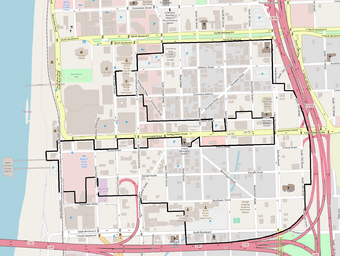Beauregard Town facts for kids
|
Beauregard Town Historic District
|
|
 |
|
| Location | Roughly bounded by North Boulevard, East Boulevard, Government Street, South 10th Street, South Boulevard, South River Road and Saint Louis Street, Baton Rouge, Louisiana |
|---|---|
| Area | about 122 acres (49 ha) |
| Built | 1806 |
| Architect | Elias Beauregard, et al. |
| Architectural style | Colonial Revival, Classical Revival, Late Victorian, Bungalow/Craftsman and Queen Anne |
| NRHP reference No. | 80001713 (original) 83000500 (increase 1) 83003611 (increase 2) 99001712 (increase 3) |
Quick facts for kids Significant dates |
|
| Added to NRHP | October 14, 1980 |
| Boundary increases | April 14, 1983 October 11, 1983 February 04, 2000 |
Beauregard Town, also known as the Beauregard Town Historic District, is a special historic area in downtown Baton Rouge, Louisiana. It was planned way back in 1806 by a person named Elias Beauregard. This neighborhood is very old, being the second-oldest in Baton Rouge. Only Spanish Town is older!
Beauregard Town was officially recognized as a historic place in 1980. This means its unique buildings and layout are protected because they are important to history.
Contents
What is Beauregard Town?
Beauregard Town is a neighborhood with a rich history. It is located in the heart of Baton Rouge. The area is bordered by North Boulevard, South Boulevard, East Boulevard, and Saint Louis Street.
It's known for its old buildings and interesting street design. Many of the buildings show different styles of architecture from the past. These styles include Colonial Revival, Classical Revival, and Queen Anne.
How Was it Designed?
The design of Beauregard Town is quite unique. Elias Beauregard planned it in a way that was common in Europe at the time. A main street, called Government Street (or "Grand Rue"), runs right through the middle.
Four other streets meet Government Street at diagonal angles. These streets are Beauregard, Grandpre, Penalvert, and Somerulos. They form an "X" shape across the neighborhood. This layout makes the area easy to explore and gives it a special look.
Who Are the Streets Named After?
Many streets in Beauregard Town are named after important people or places from its early days.
- Beauregard Street is named after Elias Beauregard himself. He was the person who planned the town.
- Grandpre Street honors Don Carlos Louis Boucher de Grand Pré. He was a Spanish leader in 1806 when the town was created.
- Penalvert Street is named for Luis de Penalver. He was a Roman Catholic Bishop in 1806.
- Somerulos Street remembers the Marquis de Someruelos. He was a Captain General of Cuba.
Other streets were named after rulers like Philip, Louis, and Napoleon. Some were even named after countries and continents, such as Spain, France, America, and Europe.
Famous Buildings in the Area
Beauregard Town is home to several historic buildings. These buildings show the different architectural styles of the past.
- The Governor Henry L. Fuqua House was built around 1834.
- The Williams House dates back to about 1890. Both of these homes are located on Napoleon Street.
- The Judge Robert D. Beale House was built around 1840. You can find it at the corner of St. Louis and Government streets.
The neighborhood also includes the Old Louisiana Governor's Mansion. This important building is listed separately on the National Register of Historic Places.
Growing Over Time
Over the years, the Beauregard Town Historic District has grown bigger. Its boundaries have been expanded several times to include more historic buildings.
- In 1983, the privately owned Levy Hay Warehouse was added. It was built in 1920.
- Later in 1983, the state-owned Armour Building was included. This building was constructed in 1929.
- In 2000, more state-owned houses were added to the district. These homes feature Bungalow/Craftsman and Queen Anne styles.
These additions help protect more of Baton Rouge's valuable history.

